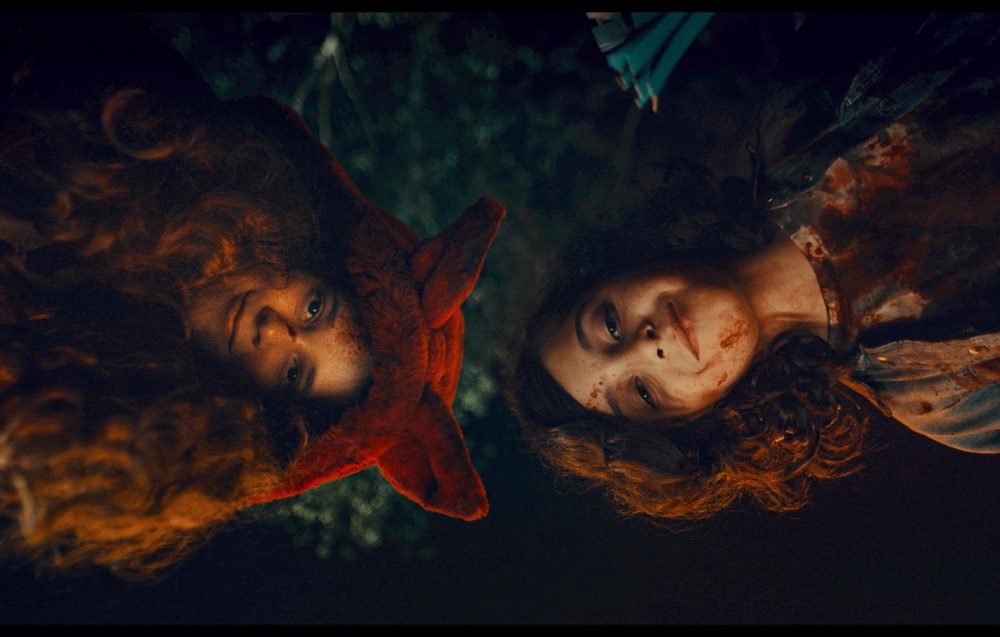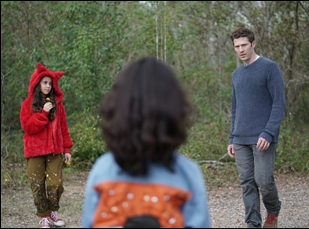Long before anyone starts to think of demonic possession or alien invasion or whatever that green, glowing substance there is at the bottom of the cave that begins to wreak havoc on the families in “There’s Something Wrong with the Children,” one can tell that Margo (Alisha Wainwright) has stopped enjoying the camping trip she’s on with her partner Ben (Zach Gilford) and their two friends Ellie (Amanda Crew) and Thomas (Carlos Santos), who have brought their kids Lucy (Brielle Guiza) and Spencer (David Mattle). At first, it seems that she enjoys the company, the remote cabin that she’s booked on AirBNB coming to life with the sound of the kids playing and enjoying a glass of wine with her longtime friend Ellie, who looks like she could surely use the break from looking after them. However, things take a turn when Ellie brings up the prospect of Margo having her own kids, seeing how naturally Ben takes to playing catch with hers and despite their longtime friendship, she seems not to know when to stop pushing when it’s a question that Margo tired of long ago.
A visit to the aforementioned cave where Lucy and Spencer are overcome with some sort of malevolent spirit that causes them to bedevil the adults is the obvious threat in Roxanne Benjamin’s deviously delightful second feature, but working from a clever script by T.J. Cimfel and Dave White, there’s a deeper fear running through it as Margo is pressed uncomfortably about her biological clock and even if she has no desire to procreate has to wonder if she’s mother material when she is asked to watch over Lucy and Spencer for a couple hours and things quickly spiral out of control. After watching a young park ranger, underestimated by her peers, wrestle with a bear in “Body at Brighton Rock,” Benjamin has as good as grip as any on the tale of the campers who appear to be faced with far more than what they can handle, taking advantage of what assumptions an audience might make, not simply in regards to genre, but in general cultural attitudes, to spring more than a few surprises.
Steeped in a bone deep love of the creepy kid subgenre, “There’s Something Wrong With the Children” knows when to zag from expectation from its very first shot and while the kids romp through the woods, terrorizing any and all who cross their path, Benjamin and crew have just as much fun upsetting the apple cart. The scrappy new offering from Blumhouse debuts this week on digital and on demand before streaming later this year on MGM+ and Benjamin generously took the time to talk about this surefire late night staple, reimagining the film originally titled “The Ravine” to fit the locations that were available and generally going against the grain to make a satisfying chiller.
I’d been talking to Blumhouse about doing something and they had sent me another script look through and then I had sent them some stuff and from the script I had sent them, I think they got a sense that I love shooting outdoors and I deal a lot with female protagonists and they said, “Oh, we think we have a script that might be a good fit.” So they sent me a script called “The Ravine” at the time and as soon as I read it, I thought “This has so much more meat to it than a lot of horror scripts that I read” and it has to do with more adult relationships, which I don’t feel like I see as much these days. That was really interesting to me and also the POV flip between two protagonists that happens was very much a draw like, “Ooh, that would be tough to do. How would I shoot that to change this POV and make it feel like a natural progression between these two characters?” So that’s where I came in.
Was coming at something that you didn’t originate yourself a different experience for you?
Yes and no. I really feel I gained some ownership over it because I had to make so many changes in production, Ian’s I think that happens on any movie you make, whether you write it or not. Like I said, it was called “The Ravine” and there’s no ravines in the river delta of Louisiana, so you can’t [set it] around a ravine, so what do they have there? Well, they have these forts out in the woods, so how can that work? There was also a lot more kid action in the original script, which was super fun and great set-pieces, but with the number of days to shoot and the actual amount of time you had with the kids, it just wasn’t feasible, so [I’d think] what things do we need to save and what can I change and tweak, so it still retains this creepiness and pays off the premise while also being shootable?
We lost a lot and I’m sure the $10 million version of this movie would be insane with way more kid stuff, but even shooting in COVID and with kids outdoors [where] you could only get so much at night, there were so many considerations that had to go into it. But hopefully it still very much is what [the original writers] intended from where it started and all those adult relationships were the fun part for me outside of the horror stuff because it’s just stuff I don’t get to see a lot in horror movies especially.
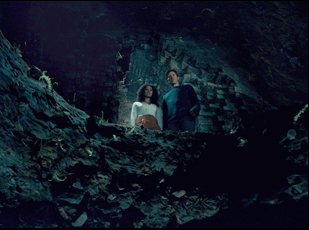
I really pushed the relationship between the two women because that’s what interested me – to be more about one of them has kids and the other doesn’t want to. That’s not a character I see a lot and I also feel like I was reacting to a lot of scripts about pregnancy and motherhood that weren’t interesting. Like you said, I haven’t seen a lot of characters that just are not on that train and don’t have that maternal bone and how that changes the relationships between your friends who do – like if they see their friend have these kids, that was really interesting to me to explore and give more to Alicia on the backend, making it more of her story and keep those themes going to it all being a reaction to the pressures of everyone saying, “Oh, but you want kids, right? Don’t you want to try this? Isn’t this what you want?” That’s a big pressure at a certain age.
[It was also important to show] you can still have kids and still be your own person and you see that with Amanda and Carlos’ characters – they still are the same people even though their friends maybe don’t think they are, so there was a lot I think to play with in there that was really interesting to me in a way I don’t normally see in horror movies.Part of the tension in this is in the camerawork – what was it to find that style of long fluid takes versus more traditionally staged multi-camera scenes?
I’m a big fan of the camera moves when it’s conducive to the story and for mostly that reason alone, so a big thing Yaron Levy, the cinematographer, and I talked about was when those moments would be and how to play with the tension and the POV especially because you’ve got a protagonist switch, [so there was a question of] how do you make that natural throughout? You’re getting bits and pieces of Alicia’s POV in the beginning before it switches over to her [entirely] but also whose perspective are we in here? One good example of that is when they discover the kids are missing in the morning. It’s like a handoff of the swirling around them and then when they realize, “Oh shit, we lost these kids,” it turns to full-on handheld, really playing with the visual aspect of the medium. What the protagonists are going through is something that I think after doing a lot of TV and in TV, you have to do a lot of standard coverage, so I couldn’t wait to bust out of that and just really play with the camerawork and make it work for the story.
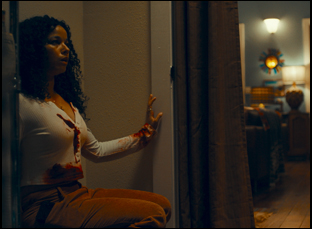
They’re my dudes. I love them so much. They were not involved until we got into post, but I always go in and I sit with them and we work through all of the themes. I send James a lot of reference music and instrument notes and we come up with a language of what the music is telling us. I’m a big fan of the music being like the inner dialogue, and I get hammered over the head in the stuff that I do, but this was something I wanted to feel very industrial and regimented and insect-like to go along with where we were [setting the film] and to play with that versus the nature that they’re in. The standard thing to do here would be to make it very nature-oriented for the score, but instead we went hardcore in the other direction, like ‘90s heavy industrial and more machine-like and hive-like, so [we] got these kind of goth darkwave [bands] like the Sisters of Mercy to open it and then Photocrime at the end, which was awesome. They let us use their shirts in there too, which was great. And then I sat down with James and we went through everything and add more themes and come up with some very specific themes for each character, but it’s great. I love working with them.
When it changed from “The Ravine,” how did you find the right location for it?
Everything on this shoot is location-based because that’s part of the production model for Blumhouse. They don’t work on stages, so it was really having to find the perfect location that suited the story and there’s a lot of changes to what was in the script for what was written. There was a lake and the houses are further apart through the woods and this was the closest we could get to that. It really behooved the story because the houses were in sight of each other, which I think makes it more scary [when] you manage to lose these kids and your friend’s right there and everything happens in between these two houses with the two families. That really helped us production-wise as well. The cabin looked nothing like [it does in the film] — it was an apartment basically and the production design, art direction and props teams were great. We ripped that whole place apart and just rebuilt it and put in all the open shelving and built that whole kitchen and all these rooms to make it very AirBNBish.
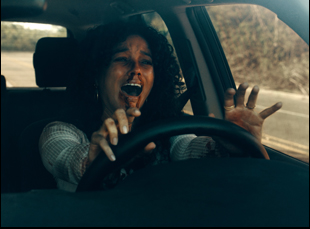
It’s tough and it feels like you can only do so much with creepy kids that hasn’t already been done. Trying to find new ways to play with that genre was definitely very concerning, but I think part of that is telling the kids treat Zach [Gilford] like he’s your younger brother who you’re just really messing with and you don’t want your parents to know, so it’s the like “I’m not touching you, you can’t get mad” kind of energy that they could bring to it. That comes across as very creepy and evil. So that was super fun to piece together and also just how much to show of what the kids are going through mythology-wise was another one because in this movie, structurally, no one’s trying to solve anything. Zach and Alicia aren’t trying to un-evil the kids. Once you’ve got evil kids, you’ve got evil kids. There’s nothing you can do at that point. [laughs] So that was also the fun of it, structurally not having to go through the boring scene of explaining the mythology, like, “Oh, we need to get to the place to do the thing and this happened in 1772 and since then, blah blah blah.” There’s no explanatory “Here’s the layout of what happening and what we need to do to fix it.” It’s really more a film about gaslighting and a reversal of who’s being gaslit in a horror movie and what that looks like from the other side. Hopefully there’s enough there that people can hang their hat on and work their own theories out because I know what I think about it, but I hope everybody else has a good enough idea there that it doesn’t feel like, “What’s happening?”
“There’s Something Wrong with the Children” will be available on digital and on demand on January 17th.




